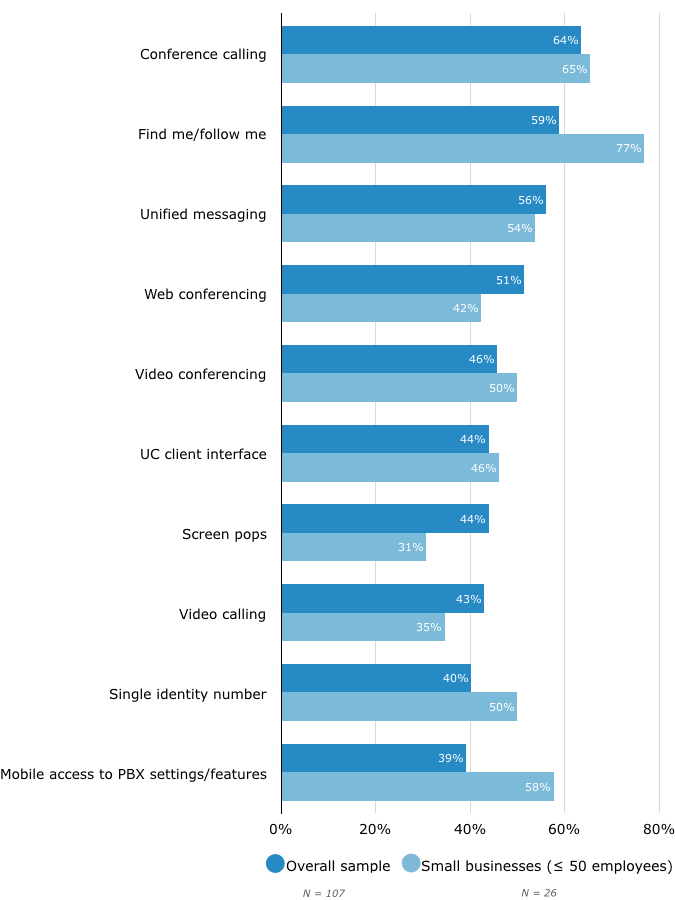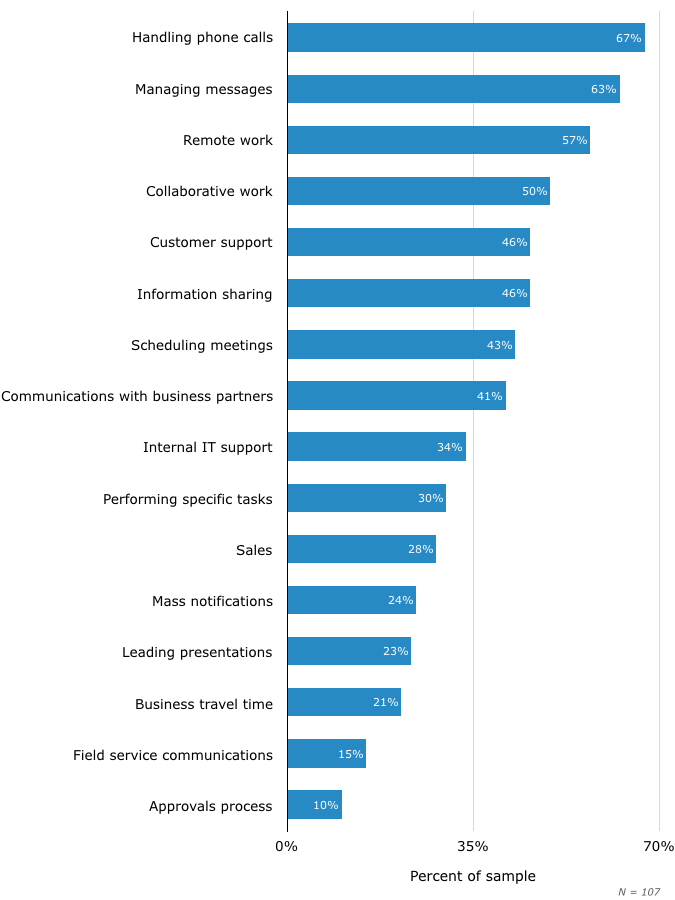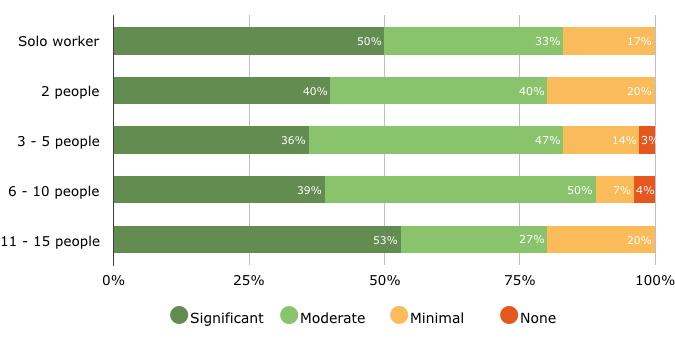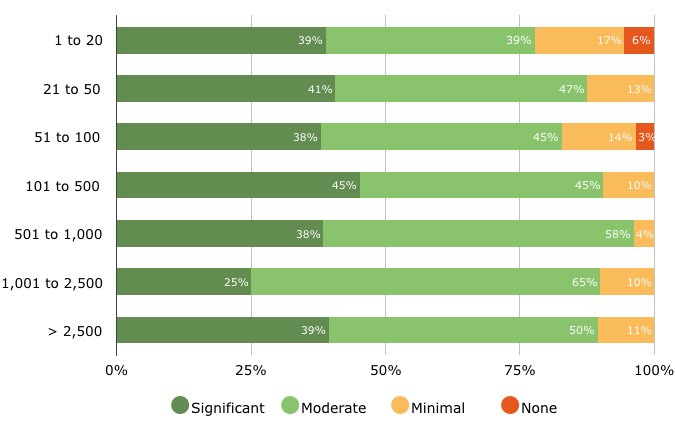IP Phone Systems for Small Business: Top Purchase Factors
Does your phone system do anything for your small business, aside from handling voice calls and voicemail?
You may not have asked yourself this question, even if you’re looking to replace your phones. Costs and reliability are probably first and foremost in your mind.
However, it’s important to look into what modern Internet Protocol (IP) phone systems offer beyond voice calling. These systems also enable helpful unified communications (UC) features, such as videoconferencing from mobile devices, Web conferencing and voicemail transcription.
To help you understand the value of IP phone systems for small business, we surveyed workers who use the UC features of their employers’ phone systems every day.
Here’s what this article will cover:
UC Features of IP Phone Systems Help Boost Productivity
Biggest Benefits of UC Include Better Call and Message Handling
Solo Workers and Large Teams Benefit Most From UC Systems
The Costs and Value of UC by Business Size
How to Narrow Down Your Options
UC Features of IP Phone Systems Help Boost Productivity
Many companies look at cost savings to justify purchasing IP phone systems for small business (also known as an IP PBX system). However, as we explained in a previous post on the subject, cost savings depend on a number of factors. Looking at potential productivity gains is often a better way for businesses to justify an upgrade.
The following chart shows the UC features that have the most significant impact on productivity for our overall sample, as well as for employees working at small businesses:
UC Features That Improve Productivity the Most

While it can be difficult to quantify productivity gains, it’s easy to recognize them, explains Andrew Prokop, director of vertical industries at Arrow Systems Integration (a systems integrator focusing on unified communications and voice/data networking).

Anything that saves me keystrokes; that saves me from having to listen to something; that saves me from having to remember something; or that keep me from having to do the same thing twice will make me more productive.
Andrew Prokop, director of vertical industries at Arrow Systems Integration
The purpose of many UC features is to cut out exactly these kinds of mindless, repetitive tasks. For instance, unified messaging eliminates the widely despised job of checking voicemail. Mobility tools are also critical productivity hacks for today’s employees.

“Businesses used to older PBX systems don’t know that these mobility features are possible or how convenient they are, but they see the benefits as soon as they can use whichever device they want from wherever they are.” Tweet this quote
Nick Galea, CEO of 3CX
For example, find me/follow me forwards calls to employees’ personal mobile devices when they don’t answer their desk phones. This feature is much more popular with small-business respondents than among our overall sample.
This makes sense: It’s hard for a business with 10 or fewer employees to ensure someone’s always in the office to take a call (if it even has a physical office).
As we explained in a previous report, your organization’s reliance on out-of-the-office work is a crucial factor in justifying UC, given the benefits for remote workers.
And as Prokop puts it, “the people who benefit most from UC aren’t just remote, but mobile: They’re moving from place to place, and need to have a steady stream of contact back to the office.”
UC provides this crucial link with the office with such functionality as mobile videoconferencing.


Web-based videoconferencing in 3CX
“Videoconferencing is, of course, being used at the moment—but it’s frequently a separate system from the phone system,” Galea explains. “Integrated videoconferencing allows an employee to easily elevate a call in order to share his or her desktop.”
Such features can help your road warriors resolve issues much more quickly than when using traditional communications, such as voice calling.
Top Benefits of UC Are Better Call and Message Handling
We’ve now seen evidence that IP PBX capabilities are quite popular with employees—but how exactly do they boost productivity?
To find out, we asked employees what aspects of their workflows benefit most from the UC functionality offered by their phone systems:
Top Business Processes and Tasks Improved by UC

Improved handling of phone calls and messages—including voicemail, email, instant messages and text messages—are the top benefits of IP phone systems with UC functionality.
Importantly, almost half our sample also say UC is key to improving customer experience at their organization. UC capabilities make it easier to provide comprehensive support.
“Very small companies are using UC for situations in which it helps them to interface with customers. They can be reachable from anywhere via softphones and smartphones, and they can use call queuing to process calls more effectively,” Galea observes.
With a cloud-based UC solution, you can configure call queues and send the calls to softphones on workers’ laptops. This allows you to easily create a call center for your customers, even if all your employees work from home.
Solo Workers/Large Teams Benefit Most From UC Systems
Team structure is one of the most important factors to consider when gauging the level of UC functionality your phone system needs.
Looking at our respondents’ team size, we can see that UC is particularly important for employees who work alone as well as for employees in teams of more than 10 people:
By Team Size: Value of UC System

“UC offers the biggest bang for the buck for people who work in teams, … because teams need to have communications with a number of different people and gather a lot of data on a real-time basis throughout the day,” Arrow Systems Integration’s Prokop says.
This is why over half the respondents in our sample who work in teams of more than 10 people see “significant” value in their systems.
However, UC systems benefit smaller teams, as well: 89 percent of respondents who work in six- to 10-person teams say their systems offer “significant” or “moderate” value.
You may be asking yourself why UC tends to benefit solo workers more than workers in smaller teams. 3CX’s CEO Galea helps clarify why smaller teams don’t get the same level of benefits out of a UC solution:
“If you’re sitting in a room with three to four people, you can easily reach out without any communications system in place simply by walking over to a coworker. As soon as you outgrow that, the office gets bigger, you have different teams in different rooms and people are out of the office more frequently.”
In the latter scenario described by Galea, the productivity benefits of a UC solution are obvious; less so in the former scenario.
Galea continues that UC also benefits “solo workers who may be teleworking from home, [since they] are completely integrated into all business communications, instead of being somewhat isolated.”
The Costs and Value of UC by Business Size
We’ve already seen a number of ways in which business size impacts the value of UC functionality. Maybe you’re still wondering whether UC offers enough value for a small business to justify investing in a more advanced phone system.
As it turns out, this technology can equally benefit the full spectrum of company sizes:
By Business Size: Value of UC Systems

The same number of respondents from the very smallest businesses and the very largest enterprises say their UC system offers “significant” value.
In fact, the vast majority of respondents from all business sizes report “significant” or “moderate” benefits.
Of course, small businesses don’t have as much as enterprises do in their CAPEX or OPEX budgets to invest in a full-blown UC solution—but don’t let this scare you away. The results of our survey indicate a wide price range for UC systems:
Average Price of UC Phone System, by # of Employees in Business

The averages in the chart factor in total upfront license fees for on-premise solutions, or one year of annual subscription fees for cloud-based solutions.
The price of a system for a business with one to 20 employees is only $16,867. But the cost increases astronomically for businesses above 2,500 employees to over $1 million.
In other words: An enterprise will pay nearly 100 times as much for a system as a very small business.
Prokop notes you can keep costs down as your business grows by investing in a solution with flexible, user-based licensing.
“The better products are the ones that allow you to upgrade your system by licensing, as opposed to adding new services, servers, other pieces of hardware etc. This is what cloud is all about—as long as you can connect to the cloud, you can get access to the service,” he says.
With a cloud solution, you can easily add new users, whereas adding users can necessitate additional hardware investments with some on-premise systems.
Additionally, some cloud UC providers allow you to activate add-on features, such as call recording, on the fly for specific users, as opposed to licensing a new piece of software or hardware for the entire company.
How to Narrow Down Your Options
Now that we’ve looked at the costs and value of UC for smaller organizations, you can begin short-listing vendors that best fit your needs:
Determine the level of UC functionality your organization needs by meeting with team leaders. Team size and structure critically impacts the value of a solution, so talk to team leads about what functionality they need most. You can also talk to remote and mobile workers about how a new phone system can make their workdays easier.
Read reviews of small-business phone systems and cloud-based UC systems. If you’ve determined you do need UC but that an enterprise-grade solution isn’t quite right for you, consider small-business UC vendors such as Vonage and RingCentral.
Identify the competitors of vendors on your short list to expand your range of options. Market share and analysis reports are particularly useful for this purpose, such as Gartner’s Magic Quadrant for Unified Communications as a Service, Worldwide.
Get a more granular sense of pricing in the market. You can download our business VoIP pricing guide, which lists detailed pricing for popular vendors.
View the top 10 UC providers for small to midsize businesses, based on the results of the surveys we’ve discussed throughout this report.